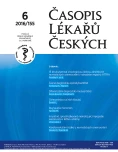Differential diagnosis of monoarthritis
Authors:
Kateřina Zegzulková; Šárka Forejtová
Authors‘ workplace:
Revmatologický ústav
Published in:
Čas. Lék. čes. 2016; 155: 299-304
Category:
Review Article
Overview
Making the diagnosis of monoarthritis can be quite difficult, because in contrast with polyarthritis just a few clinical data is available and wide diagnostic spectrum is present.
The diagnosis of inflammatory rheumatic disease is usually in responsibility of a rheumatologist, but we know from experience that is necessary to carry out the basal differential diagnostic assessment as soon as possible to begin the optimal therapy. General practitioners and orthopaedists are usually first to face this problem.
Monoarthritis can be divided into non-inflammatory arthritis where activated osteoarthritis and trauma belongs and inflammatory arthritis, which include gouty arthritis, chondrocalcinosis, infectious arthritis, juvenile idiopathic arthritis, spondylitis, incipient rheumatoid arthritis and many others.
The article also focuses on the management of patients with monoarthritis where detailed history, careful clinical joint examination and the nature of arthritis assessment is necessary for differential diagnostic considerations. Our balance sheet further facilitate imaging, arthrocentesis with the analysis of synovial fluid and of course the laboratory examination.
Keywords:
monoarthritis, gout, septic arthritis, acute arthritis, pseudogout, chondrocalcinosis, infectious arthritis
Sources
1. Ma L, Cranney A. Acute monoarthritis: What is the cause of my patient’s painful swollen joint? CMAJ 2009; 180(1): 59–65.
2. Freed JF et al. Acute monoarticular arthritis. A diagnostic approach. JAMA 1980; 243(22); 2314–2316.
3. Mjaavatten MD et al. Pattern of joint involvement and other disease characteristic in 634 patients with arthritis of less than 16 week´s duration. J Rheumatol 2009; 36(7): 1401–1406.
4. Mathews CJ et al. Bacterial septic arthritis in adults. Lancet 2010; 375(9717): 846–855.
5. Weston VC, Jones AC et al. Clinical features and outcomes of septic arthritis in a single UK Health district 1982–1991. Ann Rheum Dis 1999; 58: 214–219.
6. Arthritis Research UK. Clinical assessment of the musculoskeletal system. www.arthritisresearchuk.org
7. Kaandorp CJ et al. Risk factors for septic arthritis in patients with joint disease. A prospective study. Arthritis Rheum 1995; 38: 1819–1825.
8. Morgan DS et al. An 18 year clinical review of septic arthritis from tropical Australia. Epidemiol Infect 1996; 117(3): 423–428.
9. Bardin T. Gonococcal arthritis. Best Pract Res Clin Rheum 2003; 17(2): 201–208.
10. Giannotti S, Bottai V, Dell'Osso G et al. Algodystrophy: complex regional pain syndrome and incomplete form. Clin Cases Miner Bone Metab 2016; 13(1): 11–14.
11. Burson LK, Schank CH. Charcotneuroarthropathy of the foot and ankle. Home Healthc Now 2016; 34(3): 135–139.
12. Schneekloth BJ, Lowery NJ, Wukich DK. Charcot neuropathy in patients with diabetes: an updated systematic review of surgical management. J Foot Ankle Surg 2016; 55(3): 586–590.
13. Caldwell DS, McCallum RM. Rheumatologic manifestations of cancer. Med Clin North Am 1986; 70: 385–471.
14. Sack K. Monoarthritis: differential diagnosis. Am J Med 1997; 102: 30S–34S.
15. Goldenberg DL. Acute infectious arthritis: a review of patients with nongonococcal joint infections. Am J Med 1976; 60: 369–377.
16. Simon H. Assessment, investigation, and management of acute monoarthritis. J Accid Emerg Med 1999; 16: 355–361.
17. Katzenstein D. Isolated Candida arthritis: report of a case and definition of a distinct clinical syndrome. Arthritis Rheum 1985; 28: 1421–1424.
18. Boulware DW et al. Tuberculous podagra. J Rheumatol 1985; 12: 1022–1024.
19. Margaretten ME et al. Does this adult patient have septic arthritis? JAMA 2007: 1478–1488.
20. Mathews CJ, Coakley G. Septic arthritis: current diagnostic and therapeutic algorithm. Curr Opin Rheumatol 2008; 20: 457–462.
21. Steere AC et al. Musculoskeletal manifestations of Lyme disease. Am J Med 1995; 98: 44S–48S.
22. Boss GR, Seegmiller JE. Hyperuricaemia and gout. Classification, complications and management. N Engl J Med 1979; 300: 1459–1468.
23. Janssens HJ et al. A diagnostic rule for acute gouty arthritis in primary care without joint fluid analysis. Arch Intern Med 2010; 170: 1120–1126.
24. Malik A et al. Clinical diagnostic criteria for gout: comparison with the gold standard of synovial fluid crystal analysis. J Clin Rheumatol 2009; 15: 22–24.
25. Calin A, Fries JF. An "experimental" epidemic of Reiter’s syndrome revisited: follow-up evidence on genetic and environmental factors. Ann Intern Med 1997; 98: 44–48.
26. British Society for Rheumatology Guidelines 2006. http://rheumatology.oxfordjournals.org/content/45/8/1039.full
27. Pavelka K a kol. Revmatologie. Maxdorf, Praha, 2012: 39–40.
Labels
Addictology Allergology and clinical immunology Angiology Audiology Clinical biochemistry Dermatology & STDs Paediatric gastroenterology Paediatric surgery Paediatric cardiology Paediatric neurology Paediatric ENT Paediatric psychiatry Paediatric rheumatology Diabetology Pharmacy Vascular surgery Pain management Dental HygienistArticle was published in
Journal of Czech Physicians

- Metamizole vs. Tramadol in Postoperative Analgesia
- Metamizole at a Glance and in Practice – Effective Non-Opioid Analgesic for All Ages
- Advances in the Treatment of Myasthenia Gravis on the Horizon
- Current Insights into the Antispasmodic and Analgesic Effects of Metamizole on the Gastrointestinal Tract
- Spasmolytic Effect of Metamizole
Most read in this issue
- Differential diagnosis of monoarthritis
- Hand osteoarthritis
- Raynaud's phenomenon
- Immune mediated necrotizing myopathy associated with statin treatment
